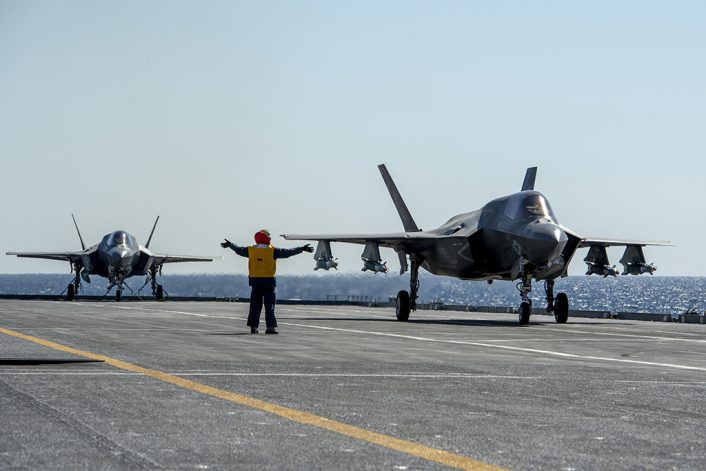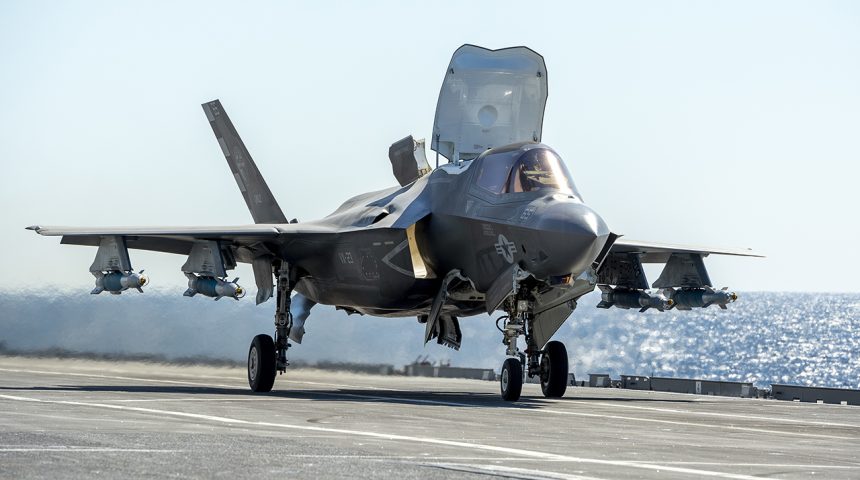The “Ready for Operations” campaign continues with U.S. F-35B Lightning II aircraft from VX-23 loaded external stores, a configuration unofficially referred to as “Beast Mode”.
Let’s explain it again: “Beast Mode” is not an official or technical term; it’s just a common way an F-35 configuration involving external (and usually internal) loads has been dubbed. Although many other aircraft types can carry an impressive amount of external weapons (just think to the recent F-15E test we have reported about few days ago), many call any configuration involving external loads either “Beast Mode” or “Bomb Truck”.
Another way of calling a non-stealth configuration is also “Third Day of War” loadout: as opposed to a “First Day of War” loadout, in which the F-35 would carry weapons internally to maintain its LO (Low Observability), the configuration with external stores is expected to be used from the third day of an air campaign when, theoretically, enemy air defense assets (including sensors, air defense missile and gun systems and enemy aircraft) have been degraded by airstrikes (conducted also by F-35s in “Stealth Mode”) and the battlespace has become more permissive: in such a scenario the F-35 would no longer rely on stealthiness for survivability so it could shift to carrying weapons on the wing pylons. Even though these conditions are not always met, LO is not always needed: as happened when the F-35A was called to carry out the first air strike in the Middle East, or when the U.S. Marine Corps F-35B carried out the first air strike in Afghanistan.
For this reason, launching and recovering the F-35B in “Beast Mode” is part of the testing campaign currently underway off the U.S. East Coast to verify the compatibility between the 5th generation fighter aircraft and the flagship of the Marina Militare (Italian Navy), ITS Cavour.
Two specially instrumented U.S. F-35Bs from Air Test and Evaluation Squadron 23 (VX-23) at Naval Air Station Patuxent River (NAS Pax River), Maryland, are currently operating aboard Italian aircraft carrier ITS Cavour. The two Lightnings of the Integrated Test Force (ITF) are conducting intensive trials, testing the integration of the aircraft aboard the ship, the logistics, simulated combat operations and emergencies. Cavour is in phase one of its two-phase “Ready for Operations” campaign.

At the moment it is still unclear whether the new Shipborne Rolling Vertical Landing (SRVL) will be tested on ITS Cavour, as happened on the British aircraft carrier HMS Queen Elizabeth.
The rolling technique is intended to allow pilots to recover to the ship with more stores: the combination of thrust from its rotating nozzle, lift-fan and lift generated by the wing as an effect of the (slow) forward movement of the aircraft can save up to 7000lbs greater all up weight (UAW). Without the SRVL technique, the F-35B would be forced to jettison some or all of its external store when returning to the ship.
Meanwhile, the first images of the F-35B in sort-of “Beast Mode”, loaded with inert GBU-12s in preparation to launch for the first ski jump short takeoff (STO) flight test aboard Italian aircraft carrier, have just been released. While we don’t know if the aircraft had also weapons in the internal weapon bays, the photos show that the external AAM (Air-to-Air Missile) rails used for AIM-9X or ASRAAM missiles, were not mounted for this flight, carried out on Mar. 14, 2021 (the day the weapons and external stores tests started).
Following the end of the sea trials, the ITS Cavour will be involved in the carrier qualification of the six Italian Naval Aviators that completed their transition on the F-35B at Marine Corps Air Station (MCAS) Beaufort, South Carolina. Upon return to Italy, the Italian Navy plans to perform the first flight activities with an Italian F-35B from the Cavour. As we mentioned in previous articles, the first two aircraft built went to the Navy and are now in Beaufort for pilot training, while the third one was delivered to the Air Force. Italy has plans to procure a total of 90 F-35s for the Italian Air Force and Navy: 60 F-35As and 30 F-35Bs (15 for the Marina Militare and 15 for the Aeronautica Militare).









